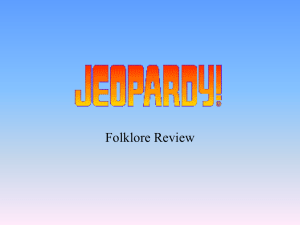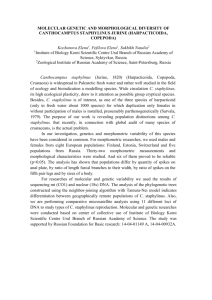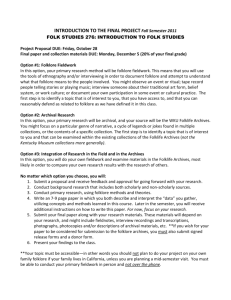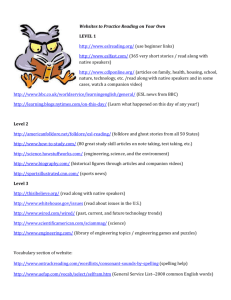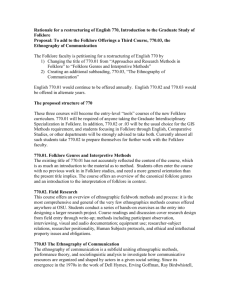Paper - EVA Moscow
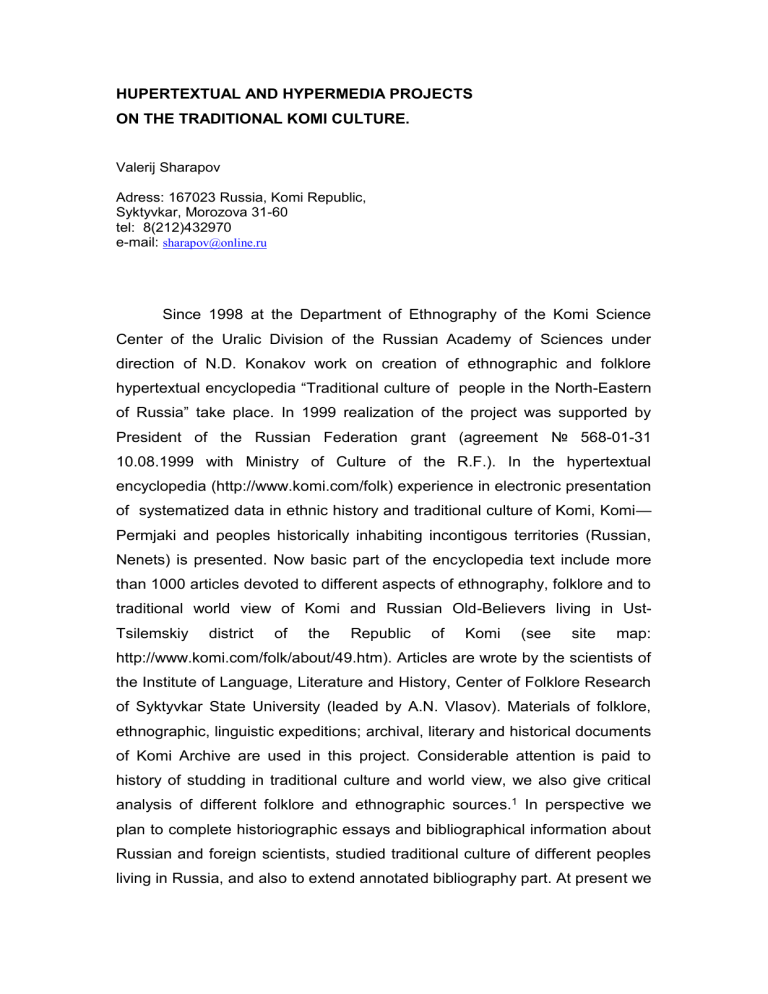
HUPERTEXTUAL AND HYPERMEDIA PROJECTS
ON THE TRADITIONAL KOMI CULTURE.
Valerij Sharapov
Adress: 167023 Russia, Komi Republic,
Syktyvkar, Morozova 31-60 tel: 8(212)432970 e-mail: sharapov@online.ru
Since 1998 at the Department of Ethnography of the Komi Science
Center of the Uralic Division of the Russian Academy of Sciences under direction of N.D. Konakov work on creation of ethnographic and folklore hypertextual encyclopedia “Traditional culture of people in the North-Eastern of Russia” take place. In 1999 realization of the project was supported by
President of the Russian Federation grant (agreement
№ 568-01-31
10.08.1999 with Ministry of Culture of the R.F.). In the hypertextual encyclopedia (http://www.komi.com/folk) experience in electronic presentation of systematized data in ethnic history and traditional culture of Komi, Komi —
Permjaki and peoples historically inhabiting incontigous territories (Russian,
Nenets) is presented. Now basic part of the encyclopedia text include more than 1000 articles devoted to different aspects of ethnography, folklore and to traditional world view of Komi and Russian Old-Believers living in Ust-
Tsilemskiy district of the Republic of Komi (see site map: http://www.komi.com/folk/about/49.htm). Articles are wrote by the scientists of the Institute of Language, Literature and History, Center of Folklore Research of Syktyvkar State University (leaded by A.N. Vlasov). Materials of folklore, ethnographic, linguistic expeditions; archival, literary and historical documents of Komi Archive are used in this project. Considerable attention is paid to history of studding in traditional culture and world view, we also give critical analysis of different folklore and ethnographic sources.
1 In perspective we plan to complete historiographic essays and bibliographical information about
Russian and foreign scientists, studied traditional culture of different peoples living in Russia, and also to extend annotated bibliography part. At present we
working on preparing for publication an ethnographic and folklore data about
Russian and Nenets. At the producing of hypertextual encyclopedia Unicode
(UTF-8) coding was used. This premised to provide correct presentation of the texts with finno-ugric transcription when viewing in NN and IE 4.0 brousers and late version. At the same time, to maximize number of users opportunity of text version is foreseeing (also intend to print informational resources) for viewing in NN and IE 3.0 brousers.
Carrying out the project on creation of hypertextual encyclopedia electronic guide based on book “Mythology of Komi” (Moscow, 1999) was made (programming — D. Kostylev, text setting, proof and edition — V.
Sharapov, O. Uljashov). This book became rare soon after publication because of limited edition and high cost. Program archive for OS DOS placed for free access http://www.komi.com/irsi/mk/index.htm One of the encyclopedia electronic guide advantages is it’s availability for all users, simple tastes to system resources of PC and to capacity of magneto-optic mediums(program can exploit from standard floppy disk). Hypertextual version of book “Mythology of Komi” is placed also on TELEROSS—KOMI portal (http://www.komi.com/folk/myth), on the Komi Science Centre of the
Uralic Division of the Russian Academy of Sciences
(http://www.komisc.ru/illi/myth) and Novosibirsk
(http://www.sati.archaeology.nsc.ru/myfolog) sites.
In 2000 members of the Department of Ethnography created software and masterdisc hypermedia “Traditional Komi Culture” (international project was directed by A.-L. Siikala, P. Hakkamies) at technical basis of the
Department of Folklore in University of Helsinki, “Provisual” multimedia studio and Archive of Literally Society of Finland (Joensuu). Now show-version of hypermedia is tested in Estonia National Museum and at the Department of
Folklore in University of Helsinki. Multimedia encyclopedia structure include following issues: ethno-linguistical atlas (dialects of Komi language and ethnographic groups of Komi), ethnography (ethnic history, traditional, settlements and dwelling, traditional food, clothes, traditional ceremonies,
plays and leisure); folklore (fairy- and non-fairy prose, epos of Komi people, small folklore genres, ritual folklore, song folklore, popular music); mythology
(sources and literature, traditional world view, figures of Komi folklore and mythology, magic and witchery, folk beliefs, mythology and folk art); folk fine arts (Perm animal style, traditional ornamental pattern, arts and crafts); folk knowledge (folk calendar, metrology, medicine, ethnopedagogics); ethnoarchive (historiography, biographies of researchers, bibliography, fulltext electronic library in Komi ethnography and folklore); multimedia (video, audio photo collections). Besides full-text versions of separate editions and articles in ethnography and folklore electronic library includes a number of dictionaries which connected with main informational resources of hypermedia by cross-hyperlinks. The last issue includes about three hours of video and audio authentic records of Komi folklore and rituals which are results of field research over 1970
—1990 of members of the Departments of
Ethnography and Folklore of Institute of Language, Literature and History.
Video material about Komi living on rivers Pechora and Vichegda was placed at our disposal by Art Leete (Estonia National Museum). Instrumental compositions by Komi folklore motifs carry out by A. Chuvjurov are used in musical design of encyclopedia. In program environment design elaboration took part painters-ethnofuturists from Syktyvkar J. Lisovsky and P. Mikushev.
2
Represented in hypertextual encyclopedias materials in folklore and ethnography are view in a context of academic themes “Evolution and interaction of cultures of peoples in the European North - Eastern part of
Russia” and “Spiritual culture and traditional world view of peoples living in the
European North - Eastern part of Russia”. Structure and search system of hypertextual encyclopedia take bearings on ethnographic and folklore classical approach in typology and classification of different traditional culture’s texts. At the same time using of hypertexrual and hypermedia tehnology allow to combinate hronological, geographical and thematical approches i.m. to orientate free in choice of corresponding informational blocks of encyclopedia (text, graphic, audio, video).
3 Problem of objectivation of different texts communications is priority line viewed in informational
organization of encyclopedia. Using of modern technologies allow demonstrate more visual some sensible (semiotics) connections between different aspects of traditional culture.
4
It must be stressed that these projects are directed on a creation of dynamic hypermedia data base which can actually be enlarged, corrected, changed in structure both by authors of the projects and other specialist in traditional culture. In August 2000 first results of the projects were demonstrated in IX International Finno-Ugric Congress (Tartu, Estonia). As regards perspectives, in 2001 initiative of National Museum of Republic of
Komi on creation of open computer informational ethno-cultural center was supported by J. Soros Fund (The 1st Cultural Policy Competition 2001;
Project "Tree of Life"). This center will be open on a base of new ethnographic exposition (team-work project of Departments of Ethnography and Folklore of Institute of Language, Literature and History, National
Museum of Republic of Komi, Center of Folklore research of Syktyvkar state
University). Within this project web-site on ethnographic funds and expositions of National Museum of Republic of Komi will be create. Work on development and assemblage of graphic, audio and video supplements and creation of issues about Russian and Nenets will be go on. At the end of 2001 resources of hypertextual and hupermedia encyclopedias on traditional Komi culture will be accessible for all visitors of museum. translation from Russian into English Viktory Vlasova (Syktyvkar)
1 Sharapov V. Ethnographic and Folklore Web-Encyclopedia of the
Traditional Komi Culture // Финно-угорские народы: проблемы этнической и языковой идентификации, Сыктывкар, 1999, с.35-36
2 Ugriculture. Contemporary Art of the Fenno-Ugrian Peoples. Helsinki, 2000, p. 57-70.
3 Капица Ф.С. Современные гипертекстовые системы и фольклор //
Фольклор. Комплексная текстология, М., 1998, с.192-202; Bella Dicks and
Bruce Mason, Hypermedia and Ethnography: Reflections on the Construction of a Research Approach // Sociological Research Online, vol. 3, no. 3, 1998
(http://www.socresonline.org.uk/socresonline/3/3/3.html)
4
According to A. K. Bayburin’s definition, ethnic culture can be presented not as collection of it’s separated elements, but as indissoluble text (for example, traditionally existing communications of an object world can find their expression in vocabulary, rituals, mythological conceptions). It is examination of interactions between different forms of traditional culture that allow to approach to studding of some mechanisms of ethnic culture. Байбурин А.К.
Некоторые вопросы изучения объективированных форм культуры //
Памятники культуры народов Европы и европейской части СССР.
Сборник МАЭ, вып. XXXVIII, Л., 1982, с.13-15.
